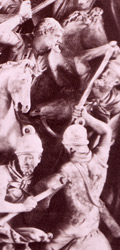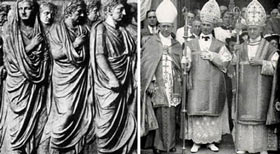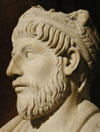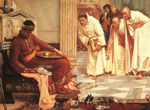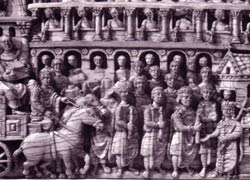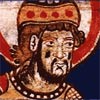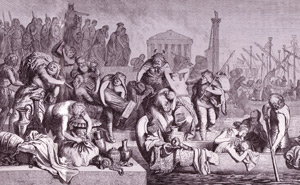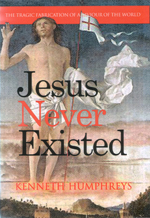Better days ... Rome vanquishes the barbarians.
Rome had been able to resist, defeat and conquer barbarians for a thousand years.
Barely sixteen years after the triumph of Christianity as the 'one true religion' Rome fell.
A change of clothes for the Senate
"Make me bishop of Rome, and I'll become a Christian immediately."
A quip attributed by Jerome to Rome's City Prefect and wealthy pagan aristocrat Vettius Praetextatus (320-84) (Contra Ioannem Hierosolymitanum, 8).
After the death of Praetextatus, Jerome assured a distressed Roman matron that, good man or not, Praetextatus most certainly was in hell.
Julian – the one bright exception in a family of fools.
Julian jettisoned his purported Christianity the moment he became Augustus. His reign terrified the bishops. He was assassinated (probably by a Christian soldier) within three years.
Foolish
378 Adrianople
Eastern Emperor Valens, a Christian zealot, rather than wait for the western emperor and share 'glory' attacked the Goths prematurely – and lost real bad.
Grey eminence of Milan
Ambrose
In the 380s, in the wrangle with the remnants of the pagan aristocracy in Rome over the Altar of Victory, the Church vendetta was led, not by Damasus in Rome, but by Ambrose in Milan.
In 390, it was again Ambrose in Milan, not Siricius in Rome, who forced emperor Theodosius to do penance after that spiteful autocrat set Gothic mercenaries onto the city of Thessalonika, killing thousands.
Chicken
"The amusement of feeding poultry became the serious and daily care of the monarch of the West."
– Gibbon (Decline and Fall, ch. 29)
"Uncomprehending that his favourite chicken had perished, Honorius was relieved to learn it was only the city!"
– Procopius, History of the Wars (III.2.25-26)
Western Emperor Honorius – more concerned for a hen called 'Rome' than a city!The 26-year-old and his court were hiding in Ravenna as the Goths ravaged Italy and sacked Rome in 410.
Power behind the throne
438 Pulcheria receiving the 'sacred bones' of John Chrysostom back into Constantinople.
Hymn to Proserpine (extract)
(After the Proclamation in Rome of the Christian Faith)
Thou hast conquered, O pale Galilean; the world has grown grey from thy breath;
Though all men abase them before you in spirit, and all knees bend,
I kneel not neither adore you, but standing, look to the end.
Though the feet of thine high priests tread where thy lords and our forefathers trod,
Though these that were Gods are dead, and thou being dead art a God,
Though before thee the throned Cytherean be fallen, and hidden her head,
Yet thy kingdom shall pass, Galilean, thy dead shall go down to thee dead.
– Algernon Charles Swinburne (1837-1909)
Most of the 4th and 5th century Roman emperors were remarkably young – an inevitable consequence of combining the notion of hereditary monarchy with the use of violence as a legitimate instrument of ambition. Across the Roman world, in every imperial court – and there were now several – a coterie of bishops, female regents and eunuchs vied for influence and power. For two hundred years, seemingly limitless funds had poured into the coffers of the Church, much of it plundered from the treasuries of pagan sanctuaries. The bonanza intensified the ferocious infighting that had always characterised Christianity – Trinitarian versus Arian, Donatist versus Catholic, Alexandria versus Constantinople, Monophysitism versus Nestorianism, Milan versus Rome. Christianity, far from unifying the Roman world with a single faith, rent division and civil conflict throughout the empire.
Rotting from the head After the ascendancy of Emperor Constantine, Roman civilisation gravitated increasingly towards the new Christian capital on the Bosphorus. Members of the court and the imperial bureaucracy moved east with their emperor to the "New Rome". Throughout the eastern empire, pagan cities and sanctuaries were robbed out to embellish the Christian metropolis with appropriate, albeit counterfeit, grandeur. In Constantinople, for the next thousand years, divine emperors and illustrious patriarchs would reign in oriental splendour as lords of the earth and viceroys of God in Heaven. Neither the sons of Constantine, nor most of the 4th century emperors that followed, had much in common with the military strongmen who had so often seized power a century earlier. The feeble sons of Constantine were followed by the equally feeble sons of Valentinian and Theodosius. Tutored from infancy by scheming churchmen, these vicious and pious adolescent emperors essentially waged civil war on their own subjects. Spending their days at court, replete with wig and face make-up, these simple-minded young monarchs – with a bishop at their ear – displayed their martial prowess by issuing increasingly vindictive edicts against heretics and unbelievers. As they laboured tirelessly (but in luxury) over such pressing issues as to whether Christ was actually God and just how virtuous was virginity, the provinces were taxed into destitution, the tax-base actually diminishing as citizens fled the towns to avoid the rapacious tax collectors. In the menagerie of eunuchs and regents, courtiers and attendants, the fiercely competitive Christian bishops, themselves habituées of the imperial palaces, established mind-control over the weak and superstitious scions of dynastic monarchy. Ambrose, Bishop of Milan 374-397, in particular, is notable in "guiding" no fewer than four monarchs, all of whom were complicit in the disintegration of the western empire. "Old" Rome was reduced to the status of a provincial city and entered a protracted period of neglect and decline. What remained of the old senatorial class looked askance at the new Jewish god that had captured the imperial enthusiasm and whose votaries claimed an exclusivity of divine favour. Throughout much of the 4th century the more enlightened of the polytheists offered determined resistance to Christianization. But disheartened by the failure of Emperor Julian's pagan "counter-revolution" (360-363), and the rout of Eugenius at the head of the last pagan legions (September 394), the Roman patrician class moved wholesale into the higher ranks of the Church. Financial penalties made it prudent, and penal legislation made it imperative, to abandon paganism. And it was not all bad. The Church offered "the officer class" an alternative career to that of the marching camp or frontier garrison, one superior in rewards of status, wealth and power – and all in safety and comfort. Not for nothing did the Church model its hierarchy on that of the army; it was a fine career for a bright young Roman who preferred to fight the hordes of Satan to the horsemen of Germany or Asia. Thanks to Constantine's "religious revolution" and the subsequent establishment of a state-endorsed Catholic Church, the manpower that might have defended the empire was drawn increasingly into the ranks of the priesthood. Within the church, these high-born hierarchs often clashed with and drove out puritan and "heretical" intellectuals. At the same time, they brought into the church much of the familiar ritual and regalia of paganism. Thus entrenched, the new Christian grandees became the recipients of imperial largesse, took up residence in palaces and appeared resplendent in the finest costumes. By and large, the bishops of western Europe were the old Roman aristocracy wearing a new hat.
What was different after the triumph of Christianity? With the willingness of the Roman elite to engage the invader seriously eroded, the only alternative defender was the hired barbarian, one under increasingly autonomous tribal chiefs. When these mercenaries failed to stem the tide lapping at the frontiers, the enemy was bribed into a temporary quiescence. A degenerate age used the accumulated wealth of a millennium to buy time – and then spent that time on building a plethora of churches, on convening protracted councils to resolve hairsplitting nuances of theology, and on the persecution of internal dissent. The soldiery, secondary to the clergy, often went unpaid, and barbarians raided unopposed. Again and again, supposed heresies, pagan religions and "philosophies" (that is rational thought and science) were criminalized with the severest of penalties. The repetition of the legislation itself gives evidence of widespread resistance. The populace of the empire had to be brought kicking and screaming to the Church of Christ. Yet the fanatical intolerance rampaged on, with increasingly more severe rescripts. Every new measure designed to crush and stamp out non-Catholic belief met with renewed resistance, disaffection from the imperial cause and civil commotion. At a time when a regeneration of the legions was most urgent, the Church/State apparatus devoted ever more resources to the persecution of its own people. In time, many would prefer the more tolerant rule of a barbarian king to the adolescent fanatics in Milan, Ravenna and Constantinople. The campaign to wipe out heterodox opinion reached a zenith with the reign of Theodosius I, late in the 4th century. Less than twenty years after Theodosius' prohibition of paganism, the city of Rome fell to the barbarians. By then, the parasitic Christian religion had fatally weakened the host body; yet as the western empire died, the psychosis of "Christian faith" had already migrated to the newcomers. The barbarian tribesmen that sacked Rome and other major cities of the empire were, notionally at least, "Christian".
Blame the Barbarians?
The melodrama is familiar enough: barbarians "pouring in" ... Rome sacked ... havoc wreaked everywhere. Words like "horde" and "onslaught" are bandied about, conjuring up images of a human flood of bloodthirsty and predatory warriors, hell-bent on rape and pillage. The only light, we are asked to believe, comes from the flickering lamps of Christian monks in remote fastnesses, keeping alive the dim flame of civilization until a bright new dawn, centuries into the future. To put things in perspective, in 410, the Visigoths of Alaric (a Christian) pillaged Rome for precisely three days before withdrawing. A generation later, in 455, Gaiseric (a Christian) and his Vandals spent just fourteen days in the city, taking what they could. The conventional 'wisdom' is a travesty, written by the winning side. The barbarians of the 3rd – 5th centuries AD – like the barbarians of the 1st century AD or 2nd century BC – had wanted a share of the good life, not the common ruination of everyone. What was different in the age of Constantine and Theodosius, compared to the age of Augustus and Hadrian, was the degenerate nature of the Roman state which opposed them. The barbarians, in the passage of centuries, had learnt from the empire: the practical skills of agriculture and horticulture; the value of armour; the exercise of power within a framework of law; even a version the new Christian religion of the Romans. But the empire, for its part, had turned in on itself, had wasted its energies on the indulgences of a theocratic tyranny, had narrowed its vision, had ruined itself – a process that began with Constantine and his plans for a Christian dynasty. The One True Catholic and Orthodox Faith, made secure by its establishment as the state religion, expropriated for its own purposes more and more of the wealth of the empire. Yet ultimately it became indifferent to the fate of the empire; Holy Mother Church was all that mattered.
|
Sources:
Chris Scarre, Chronicle of the Roman Emperors (Thames & Hudson, 1995)
Robert Graves, Count Belisarius (London, 1938)
Arthur Ferrill, The Fall of the Roman Empire (Thames & Hudson, 1986)
Helen Ellerbe, The Dark Side of Christian History (Morningstar & Lark, 1995)
Richard Fletcher, The Conversion of Europe (Harper Vollins, 1997)
Edward Gibbon, The Decline & Fall of the Roman Empire (1799
Michael Grant, The Climax of Rome (Weidenfeld & Nicolson, 1996)
Michael Grant, Fall of the Roman Empire (Weidenfeld & Nicolson, 1996)
Robert Wilken, The Christians As the Romans Saw Them (Yale UP, 1984)
Robin Fox lane, Pagans & Christians (Viking, 1986
|
||||||||||||||||||||||||||||||||||||||||
Some fifty articles are now available as a book. For your copy order:
Copyright © 2005 by Kenneth Humphreys.
Copying is freely permitted, provided credit is given to the author and no material herein is sold for profit.
